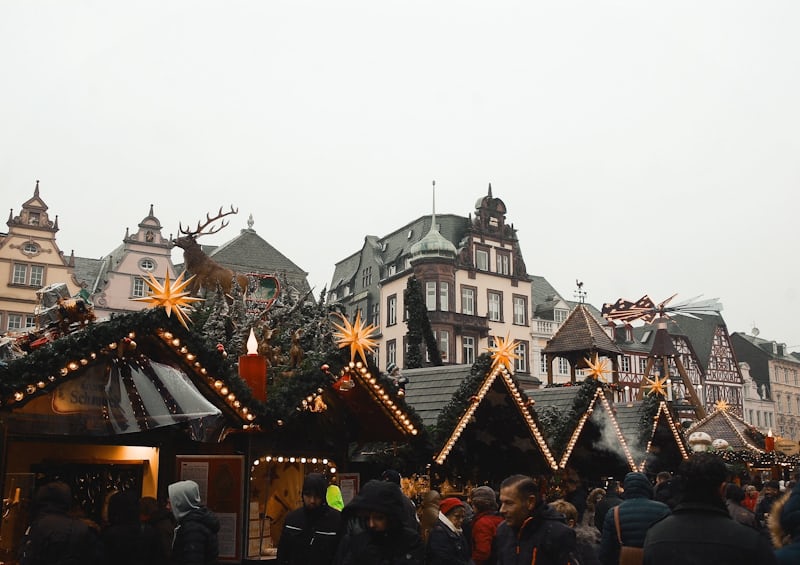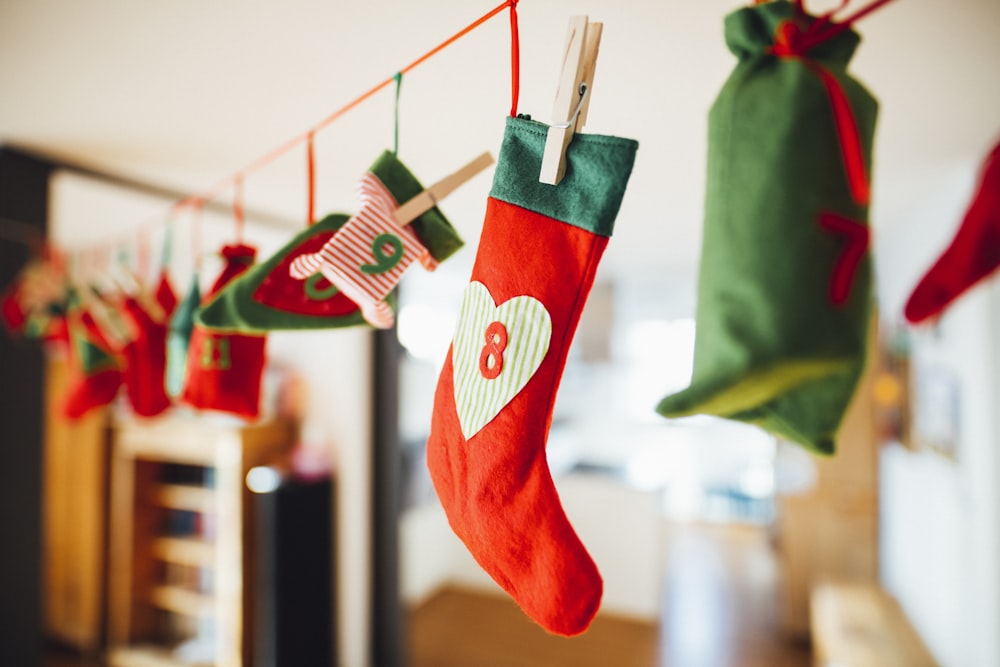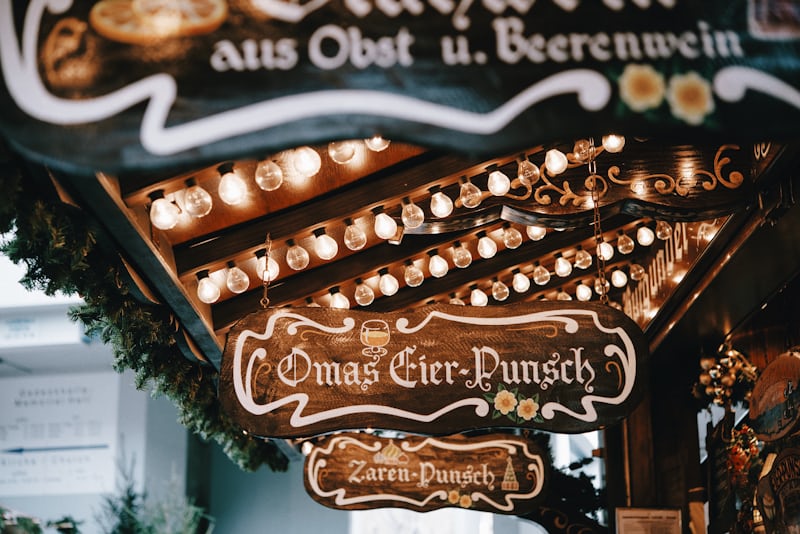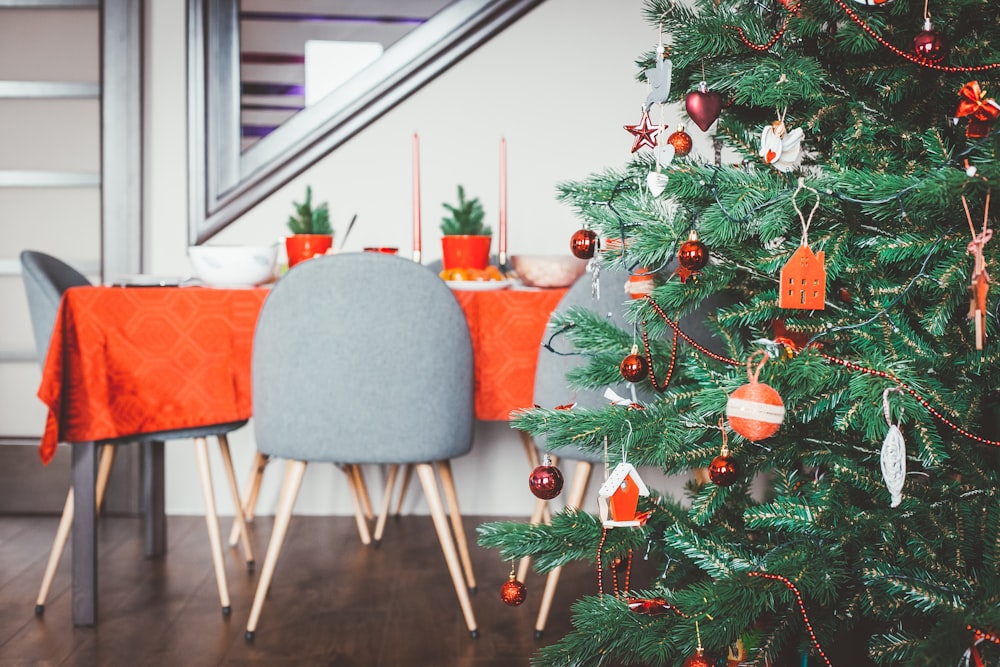Published on | Last updated on
Is this your first Christmas in Germany? Or you are just curious about Christmas Traditions in Germany? Read this (very) detailed low-down on everything that you should know about German Christmas traditions.
Officially Christmas in Germany is celebrated on 24th and 25th December, however, most Germans anticipate and prepare for Christmas throughout December. After living in Germany for all these years, I totally understand. December is one of the greyest, coldest and darkest months of the year in Germany. You need these Christmas festivities to plough through the snow and SAD.
I don’t know where we will be without the Christmas baking, aromatic mulled wine, buzzing Christmas markets, glittering trees, and cute Advents calendars to look forward to every morning.
So whether you are celebrating your very first Christmas in Germany or just passing by – continue reading to learn more about German Christmas traditions and how Germans celebrate Christmas.
Disclaimer: This blog post may include affiliate links. These links do not cost you anything but I might earn a small commission if you decide to use goods or services from one of my recommended partners. Thank you for your support to help keep this platform growing!
German Christmas Traditions FAQs
What is Heiligabend in Germany?
Christmas is celebrated over two and a half days in Germany –
- 24th December: Christmas Eve aka Heiligabend,
- 25th December: Christmas Day aka Erste Weihnachtstag and
- 26th December: Boxing Day aka Zweite Weihnachtstag
Christmas Eve is more significant than the rest of the festive days. Germans exchange Christmas presents on this evening instead of 25th December. Kids await impatiently to open their presents all day. Adults are probably exhausted after all the cooking, entertaining and hosting and look forward to some amazing Christmas feast and wine. Then there is a Christmas mass at midnight.
Christmas Day is generally a chilled out family affair with some more eating, drinking and socialising. Many German families also go to the church on this day.
What happens on 26th December or Boxing Day in Germany?
What is St. Nikolaus Day (Nikolaustag)?
St. Nikolaus Day is one of the most popular German Christmas traditions. Nikolaustag is celebrated on the anniversary of the death of St. Nicholas of Myra i.e. 6th December.
Nevertheless, it is a very special day for German kids. On the night of December 5th, they leave a pair of Christmas stocking in front of their bedroom doors for St. Nikolaus and his assistant Knecht Ruprecht.
On the morning of December 6th, they wake up to find a little present in their stockings, maybe chocolate, or a bag of gummy bears or Christmas cookies.
For a long time, St. Nikolaus was the main character in Advent celebrations in Germany. However, the German Christmas traditions began to diversify with the arrival of the Christkind.
What is the Christ Child (Christkind)?
The Christ Child is a symbolic figure of Christmas in Germany. According to the older Christmas traditions in Germany, the Christ Child brings presents to children without being seen.
The Christkind is traditionally depicted as an angelic child, dressed all in white with blonde hair, golden wings and a golden crown. It is also one of the best known German Christmas customs for a Christkind to open the Christkindlmarkt in Nuremberg each year.
Does Germany has a Santa Claus?
Yes! In Germany, Santa Claus is known as Weihnachtsmann. He brings presents on the 24th of December.
Like in many parts of the world, the Weihnachtsmann usually visits German houses on Christmas Eve, but he doesn’t sneak down the chimney. He doesn’t even have any reindeer. Instead, German Santa’s favourite mode of transport is a white horse.
Are there really Christmas post offices in Germany?
Yes! Christmas post offices (Weihnachtspostamt) or Christmas post branches (Weihnachtspostfiliale) are a real thing in Germany.
Every November, thousands of kids from all over the world write to Santa in German and 15 other languages. All letters that arrive at least 10 days before Christmas Eve are guaranteed to be answered.
The most popular German Christmas post office is in Himmelpfort, Brandenburg.
This year, Weihnachtsmann will arrive at his Christmas resort in Himmelpfort from the North Pole on November 12. He and his 20 helpers will be answering children’s letters until Christmas Eve.
What is the postal address of Santa’s post office in Himmelpfort?
Your kids (or you!) can send your Christmas wishlist to Weihnachtsmann at this address:
An den Weihnachtsmann
Weihnachtspostfiliale
16798 Himmelpfort
Make sure to post your letters to Santa before the second Advent so that they can reply in time for Christmas Eve. Don’t forget to add a return address (Absender)!
Is ugly Christmas jumper parties a thing in Germany?
Not really. It’s a relatively new fad imported from the US Christmas customs. However, a few workplaces have adopted this as a part of the unofficial Christmas parties. My fiance husband has been wearing his not-so-ugly jumper to his workplace’s unofficial Christmas party for the past two years.
Judging by the annual madness at Fasching parties all across Germany, I’m pretty sure, most Germans will be up for an ugly Christmas Jumper party.
When does the Christmas season officially start in Germany?
Usually, the first day of Christmas markets launches the official German Christmas season. It can either be the first Advent Sunday or even the last week of November. The entire Advent season is basically a month-long celebration of German Christmas customs all across the country.
Advent Season (Adventszeit) in Germany
The time between December 1st and December 24th is called Adventszeit. In Germany, Advent is celebrated on the four Sundays before Christmas. This German Christmas tradition is a religious celebration in preparation for the arrival or the “advent” of the Christ.
During this period, the real Christmas mood starts setting in German cities, streets and households. You get to open your Advents calendar every morning, bake Christmas cookies, light up Advent candles every Sunday or visit the traditional Christmas markets, enjoy warm mulled wine every evening and get cosy in fluffy blankets.
It’s pretty wholesome all around!
Advent wreath (Adventskranz)
An advent wreath is another typical German Christmas custom. Many German families set up an Advent wreath, or Adventskranz on the first Advent Sunday (the fourth before Christmas) to mark the beginning of the Advent season. A traditional German Advent wreath is made out of fir or pine branches with four coloured candles in the centre – one for each of the Advent Sundays. The candles represent a countdown to Christmas day.
Advent Calendar (Adventskalendar)
Advents calendar is one of the most beloved German Christmas traditions. No matter what their age, any German could vouch for an Advent Calendar as one of their childhood’s greatest memories.
The Advent Calendar is the ultimate way to count down the four weeks leading up to Christmas Eve.
A typical German Advent Calendar consists of 24 windows or doors (Türchen). Every day during the Advent season, you open a new door in the calendar to reveal a little present! The traditional German Advent calendar used to consist of plain 24 windows that opened to reveal Christmas scenes.
The modern German Advent calendars come in all shapes and sizes and for any taste or hobby.
My husband is the breakfast guy so for two years in a row I got him MyMuesli’s Advent calendar. While he absolutely loved the contents, we both agreed that it had lots (and LOTS) of plastic packaging for our taste.
So next year I got him a 3Bears breakfast calendar. Not only it is compact with very little plastic packaging but also budget friendlier. He is also a huge LEGO fan so obviously, some years ago he got a LEGO Advent calendar that he loved building every morning. Clearly, he is a spoiled one! 😉
Our current favourites are exit game-based advent calendars. As the name suggests these are month-long Exit game-style puzzles where you use clues to find the door for the next day.
Chocolate Advent calendars are the most popular in Germany.
You can also find calendars with puzzles and games, gadgets, makeup collections, tea assortments, spices or snacks, and whatnot. There are even naughty Advent Calendars for adults if you want to take the Christmas festivities up a notch! 😉
If you are a creative type, there are unlimited options for you. Personalised Advent calendars are quite popular in Germany and very easy to create online.
Some people also make cute DIY Advent calendars using empty paper boxes or jute bags. Not only it is sustainable but also much more personal and individual for the recipient. This is also a very engaging project for little kids.
Christmas Markets (Weihnachtsmärkte) in Germany
During Advent season the city centres of every major German city light up with Christmas markets, aka Weihnachtsmärkte. Christmas markets are arguably the most awaited in the German wintertime.
The Christmas market tradition in Germany dates back to the 15th century. Over 2,500 Christmas markets across Germany invite visitors to enjoy the Christmas mood, food and drinks.
Locals and tourists stroll among the local vendors selling Christmas decor, seasonal arts and crafts, and a wide variety of gifts, many of them still handcrafted. German Christmas markets commonly feature a nativity scene, little petting zoo, and some rides for kids.
However, the biggest star of the Christmas markets is ***drumrolls*** the street food!
You have to visit a German Christmas market at least once to enjoy all that mouthwatering German street food – locally sourced grilled sausages (Bratwürst), fried fish in a bread roll (Backfisch), beefsteak in a bread roll (Rostbrätel) or good ol’ Currywürst.
If you are a vegetarian in Germany, then there are surprisingly tons of options for you as well. Typical German Christmas market foods such as Lángos, crepes, garlic bread, käsespätzle, raclette, German open sandwiches, or sautéed mushrooms all come in vegetarian or vegan variations.
For those with a major sweet tooth, there is an endless variety of candied fruits, sweets, confections, roasted nuts and a large assortment of German-baked products.
Don’t forget to wash down all the tasty German Christmas market food with a warm mug of Glühwein or Feuerzangenbowle or a good old Kinderpunsch (for non-alcohol drinkers).
Nuremberg’s Christkindlmarkt (Nürnberger christkindlmarkt)
We cannot talk about German Christmas markets without mentioning Nuremberg’s Christkindlmarkt. This market is a traditional Christmas market held every year in the old town of the city.
Taking place since the 16th century in Nuremberg’s Old Town, Christkindlmarkt opens its doors to the public the Friday before the first Sunday in Advent.
Traditionally the Christ Child opens the Nuremberg Christmas Market every year.
At 5:30 p.m. sharp, the lights go out around the main market square. Thousands of adults and excited kids hold their breath in anticipation. All eyes are fixed on the balcony of the 14th-century Frauenkirche – when Nuremberg’s most important figure of the German Christmas custom makes an appearance – the Christ Child.
Unfortunately, Christkindlmarkt has been cancelled in 2020 because of COVID19, but here you can see a video of 2019’s opening of the market by the Christkind 2019/2020, Benigna Munsi.
German Christmas Tree (Weihnachtsbaum) Traditions
Typically Christmas tree in Germany goes up on the first Advent day, however, some families also choose to set it up just a week before Christmas.
Historically, German families decorated their homes with evergreen branches during Christmas. This German Christmas custom eventually evolved into bringing in entire trees. Back then, Germans used to decorate their Christmas trees with ripe red apples and other seasonal fruits, gingerbread, pine cones or flowers.
The modern German Christmas tree (Weihnachtsbaum) is usually a fir or pine tree. You can easily buy a Christmas tree in a garden supply store or home improvement stores such as Bauhaus, Obi, or Hornbach. Some local farmers also sell their homegrown Christmas trees (Tannenbaum) so keep an eye on the roadside billboards in your neighbourhood.
While these Christmas trees are super lush and lovely, there is a downside to buying a real tree. First, they shed a ton of pins all over. Second, you can only dispose of them in some specific places (and not your garbage bin). Lastly, they are expensive for just one-time use.
When we moved into our new apartment, we decided to have a real Tannenbaum as our Christmas tree. If a real Christmas tree is not your thing, you can easily order a sturdy reusable lush green Christmas tree on Amazon. Judging by our long post-festival clean-up, it is definitely easier to have a reusable tree instead of a real one each year.
Traditional German Christmas Tree Decorations
One of the sweetest (and my personal favourite) Christmas traditions in Germany is to decorate the tree with the entire family. Kids especially look forward to this moment every Christmas.
German Christmas tree is often decorated with live candles or strings of lights, as well as a bunch of cute ornaments. Germans typically reuse the ornaments from the past years instead of buying new ones each season.
Some of the ornaments may even be precious family heirlooms, handed down from generation to generation. Homemade cookies, candies and chocolate are also hung on the German Christmas trees. Many ornaments are also wooden, hand-painted, and represent German Christmas traditions.
Christmas Angels (Weihnachtsengel)
One of the most traditional German Christmas tree decorations is little wooden Christmas Angels! Hailing from the Erzgebirge, the mountain range between Saxony and the Czech Republic, these cute carved wooden figurines depict angels in a variety of poses, often playing their musical instruments.
Christmas Pickle (Weihnachtsgurke)
Even though its origins are unclear, this remains a popular German-American tradition from the late 19th century. A Christmas pickle is a Christmas tree decoration in the shape of a gherkin somewhat hidden between the branches. Because of its green colour, the glass pickle is not so easy to spot. The person who is the first to discover the Christmas cucumber receives an additional gift.
Christmas Tree Topper (Weihnachtsbaumspitzen)
The top of the Christmas tree is, of course, the crowning glory of all Christmas tree decorations. A festively decorated tree simply does not look complete without a glorious top.
Traditional German Christmas tree topper is made out of mouth-blown glass. But this is just one type of Christmas tree topper. Some families also use Christmas star or an angel as the ‘crown’ for their Christmas tree.
Christmas Pyramids (Weihnachtspyramide)
German Christmas pyramids consist of typically two or three, or even more stories. They are mostly made out of wood and powered by heat from candles that make fans turn, which then powers the pyramid. While historically the Christmas pyramids date back to 15th-century coal mines, they became popular during Christmas in Germany in the 18th and 19th centuries. Nowadays you will see table-sized pyramids for your living room Christmas decor to large full-sized pyramids in the German Christmas markets.
German Christmas Gifts Traditions
As mentioned earlier, Germany exchange Christmas presents on the evening of 24th December i.e. Christmas eve. If your German SO or a friend invites you to celebrate Christmas with their family then keep in mind that it is customary to bring gifts for every guest that evening.
Don’t let this stress you out though. There’s absolutely no need or obligation to splurge on gifts for each and every guest. It’s the gesture that counts not the actual value of your gift.
You can prepare for the Christmas evening with the help of your SO. Ask them in advance how many guests will be present on Christmas eve. Get some tips or ideas for different family members.
Avoid anything personal such as perfume, jewellery or clothing unless you are 100% about the taste of the recipient. For the parents, you could take wine or delicacy from your region. Avoid anything too exotic though because Germans aren’t exactly known for being adventurous with the international cuisines.
As a general rule, you want to focus on bringing gifts that have something to do with the personal interests of your SO’s family. If you are unsure then play safe by getting a nice souvenir or a travel book related to your native country. Scarves and fluffy warm socks are lovely presents for acquaintances or family members that you don’t know that well.
For close friends, family or SO, personalised coffee mugs, holiday or year photo books, photo calendars are also very popular Christmas presents in Germany.
Click here to check out the entire collection of super easy personalised gifts that you can create online with CEWE.
Or watch this quick walkthrough of how you can very easily create a personalised photo calendar using CEWE’s online platform.
Related: A Guide to Gift-Giving Traditions in Germany
Traditional German Christmas Food
Saving the best for last, one of the most anticipated German Christmas traditions is the Christmas dinner! Kids, mama, papa, tante, onkle, oma, opa – everyone – looks forward to the Christmas feast.
So what’s on the menu for a typical German Christmas dinner?
Traditional German Christmas dinner
Thankfully, Germans take their time to enjoy Christmas dinner and it can last for three or four courses over a couple of hours.
The traditional German Christmas meal features meat typically duck, goose, rabbit or a beef roast. Some families also cook fish on Christmas eve. A light starter such as soup is quite common as the first course.
The main dish is accompanied by German side dishes such as apple and sausage stuffing, Sauerkraut, red cabbage and potato dumplings or roast potatoes. Dessert typically includes Christmas Stollen, Bratäpfel, Lebkuchen, or Käsekuchen.
Red wine is typically served with German Christmas dinner. Often, sweet drink such as a port wine also accompanies Christmas desserts.
Christmas Stollen
Stollen is a German fruit bread of nuts, spices, and dried or candied fruit, coated with powdered sugar or icing sugar. It is very popular during German Christmas season and is sold as Weihnachtsstollen or Christstollen.
If you’re an experienced home baker you can try making Stollen at home. As for the rest, you can buy the most popular version of Stollen – Dresdner Stollen, at any German supermarket.
Mulled wine (Glühwein)
Nothing warms you up quicker than a mug of steaming hot Glühwein on a cold December evening. This classic German Christmas beverage consists of heated red wine with spices such as cinnamon, nutmeg, cardamom, cloves, star anise and orange slices.
It also comes with an optional shot of brandy (Glühwein mit Schuss).
Glühwein is a staple at most German Christmas markets. This special Christmas drink is served in special ceramic mugs designed for the local Christmas markets. These mugs typically have the name of the market and year engraved on them.
You don’t always have to go out in the cold to enjoy a mug of this aromatic drink. Heck, in 2020 most Christmas markets have been cancelled because of the COVID19 pandemic.
So where can you get a toasty warm cup of Glühwein in Germany?
You can totally enjoy it in the comfort of your cosy living room. Most grocery stores in Germany start selling large bottles of Glühwein in November or even October.
If you are the DIY type, it is pretty easy to make at home with some red wine and mulling spices. Cook it at home with this Glühwein recipe. Most of us already have these spices sitting in the pantry, but you can order mulling spices for your homemade Glühwein here!
However, if you prefer, you can purchase the ready-made beverage in any grocery store near you or order it online.
Feuerzangenbowle
Feuerzangenbowle is another spectacular German Christmas drink, that has become a popular German Christmas tradition in recent decades. This super potent drink is made from hot mulled wine, high alcohol-percentage rum and open flames.
Not for the faint-hearted!
Even though the concoction itself is considerably older, it was made popular by the 1943 movie “Die Feuerzangenbowle”. Nowadays it is a popular German Christmas custom to invite mates over and watch the movie over this drink.
If you’d like to try Feuerzangenbowle at home, here is an easy recipe. Don’t forget to get yourself the special Feuerzangenbowle set.
So this was my
littlelong-ass overview of German Christmas traditions. 2020 may hinder some of the most-welcomed socialisation with family and friends. But Here’s hoping that the Weihnachtsmann or Christkind pays you a visit this December. Merry Christmas!





























Good Work 🙂